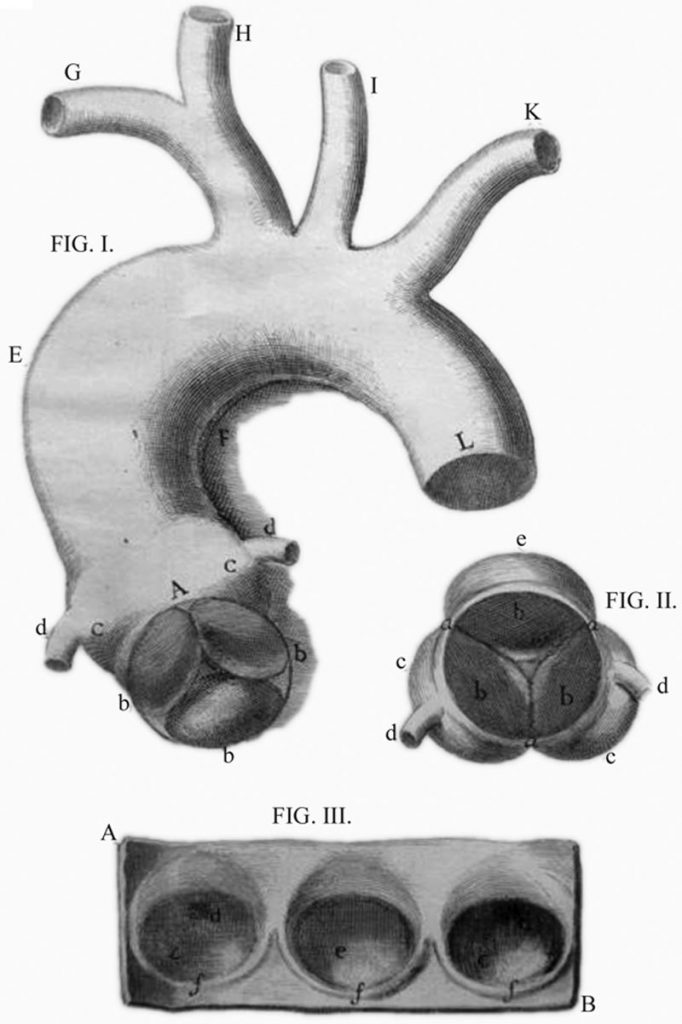Antonio Maria Valsalva, born in Imola on 17 January 1666, completed his studies at the Faculty of Medicine and Philosophy of the University of Bologna, under the guidance of Maestro Marcello Malpighi who, together with his student Giovan Battista Morgagni, formed a triad medical teaching and scientific investigation very important for the influence it had on the evolution of thought and modern medicine.
He graduated in 1687, enrolled in the Bologna medical register and immediately began to exercise successfully, nevertheless, his great passion was anatomy and anatomical research, of which he applied the investigative results to surgery and medicine, dissecting the corpses of the patients who had assisted in life, to be able to discover the real causes of death. Universal fame came in 1704, when Valsalva published the famous “De aure humana”, to which he had collaborated the trusted pupil Morgagni and who had required more than fifteen years of research and more than a thousand dissections of human heads. From the following year he obtained the position of “public lecturer” of anatomy and carried it out until his death, due to apoplexy, on 2 February 1723.
Although Valsalva made very important contributions to anatomy, discovering aorta’s breasts, splenic surgery, of which he can be considered the founder, and urinary tract surgery, only his contribution to cardiology will be examined here.

There are no works by Valsalva relating to this sector of medicine, nevertheless his numerous cardiological observations are reported widely in the writings of Morgagni and this is enough to insert him in the great masters of cardiology. Among the insights of particular importance, we include the cardiomegaly, the positive venous pulse, the acute and chronic pericarditis and the cardiac dilations found in patients who had suffered from chronic inflammation of the lungs and that Morgagni masterfully interpreted, anticipating the definition of “pulmonary heart”. With regard to serofibrinaceous and acute exudative pericarditis, in particular, Valsalva demonstrates a very remarkable diagnostic ability, as well as extreme care and accuracy in exposing the symptomatology of the patients examined. It should be noted, for example, that in his clinical histories the cardiac lesion is brought together for the
first time with rheumatism and tonsillitis or that some symptoms of chronic and adhesive pericarditis are noted, as well as the genesis of the same.
In the work of Morgagni, the “De Sedibus et Causis Morborum per anatomen investigaris”, moreover, there are numerous references to the observations of Valsalva on the pathology of the aorta and of the other arterial vessels, in particular of the aneurysms, for which he himself conceived a specific method of treatment that gave excellent results in terms of patient survival. The idea of this procedure, followed by
numerous clinicians, originated from the concept that by decreasing the mass and especially the violence of the blood, which is the immediate cause of the aneurysm, it was probably possible to delay the process of bulging the arterial walls. As a result, he developed a system of care that was as effective as it was solid support for the future, that is, a procedure that acted by taking a certain amount of blood first, and then a careful diet. The effectiveness of this method was such that, although with certain modifications, it was widely used, up to almost the entire nineteenth century, but then progressively lost in popularity since it was only applicable, as also reported by the indications of Valsalva himself, to remarkable patients physical resistance and that they were in ideal nutritional and bleeding conditions, to be able to withstand bleeding and fasting.
Another pride of the Imola doctor’s researches were those carried out on ascites, through experiments made with fire or with the mixing of different compounds, aimed at understanding the origin and method of formation of the pouring, in order to draw elements for a diagnostic formulation and prognostics. Together with his master Malpighi and Wallis, Valsalva played an enormous role in directing his pupil, Morgagni, to the discovery of the non-pathological nature of some clots found in the heart of the corpses that many thought were symptoms of pre-mortem cardiac alterations, and, moreover, he observed the effects of the ligation of the vagus nerves of the neck, thus discovering the so-called “vagus pneumonitis”, as well as the variations of the pulse rate in relation to the respiratory acts, arriving to formulate the theory that the inspiration favored the venous course of trunks near the heart.
In conclusion, we can only reiterate the fundamental contribution that Valsalva, an outstanding anatomist, a great clinician and a very valuable practical physician, gave to the development of medicine and surgery in the cardiology field, both for what he carried out and discovered personally, and for the influence he had on his pupil and on the progress of anatomical, physiological and pathological knowledge of the human being, as well as, finally, on the method of analysis, investigation and the scientific development of modern medicine.